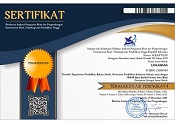ASPEK SOSIOLINGUISTIK DALAM STIKER HUMOR
Abstract
Ada dua aspek dalam sosiolinguistik yaitu aspek sosial kemasyarakatan dan aspek linguistik. Mengingat aspek sosiolinguistik dalam stiker humor ini juga terkait dengan wujud stiker itu sendiri yang juga merupakan sebuah wacana pendek, maka uraian tentang analisis wacana juga akan dipaparkan dalam tulisan ini (Roberson, D., 2016). Jadi, dalam tulisan berikut diuraikan berbagai aspek sosial yang hanya menyangkut peserta tutur, kebahasaan, dan wujud stiker yang berupa sebuah wacana, dengan metode sosiolinguistik. Aspek sosiolinguistik terdiri atas dua aspek yakni aspek sosial kemasyarakatan dan aspek kebahasaan. Hymes (1972) merumuskan pendapatnya tentang aspek sosiolinguitik dengan menyebutnya sebagai konteks dengan singkatan SPEAKING. Fishman (1968) dengan sebuah konsep yang disimpulkan dalam pernyataan: “Who speak, What language to whom, when and what end” siapa berbicara dengan bahasa apa, kepada siapa, kapan dan mengenai masalah apa. Pendapat yang lebih luas dikemukakan oleh Poedjosoedarmo. Konteks tuturan diartikan dengan komponen tutur yang meliputi 12 hal yang disingkat dengan memoteknik O, O, E, M, A, U, B, I, C, A, R, A. Konteks dengan aspek-aspek situasi tutur berdasar Leech meliputi 5 (lima) hal yang merupakan kriteria di dalam studi variasi bahasa yakni (1) Penutur dan lawan tutur; (2) Konteks tuturan; (3) Maksud tuturan; (4) Tuturan sebagai bentuk tindakan atau aktivitas; dan (5) Tuturan sebagai produk tindak verbal.
ABSTRACT
There are two aspects in sociolinguistic i.e. social aspect and linguistic aspect. Since the sociolinguistic aspect of the sticker of humor is also related to the form of the sticker itself which is also a short discourse, the description of discourse analysis will also be presented in this paper (Roberson, D., 2016). The following article described various social aspects that only concern with the speech participants, linguistic, and the form of stickers in the form of a discourse are analyzed by sociolinguistic methods. The sociolinguistic aspect consists of two aspects, namely social aspect and linguistic aspect. Hymes (1972) formulated his opinion on the sociolinguistic aspect and named it as a context with the abbreviation SPEAKING. Fishman (1968) with a concept summarized in the statement: "Who speak, What language to whom, when and what end". Other depth opinion is expressed by Poedjosoedarmo. The context of speech is defined by the speech component which includes 12 things that are abbreviated by the mnemotechniques O, O, E, M, A, U, B, I, C, A, R, A. The other context according to Leech's speech situation includes 5 matters which are the criteria in the study of variation of language namely (1) speakers and listeners; (2) speech context; (3) the purpose of the speech; (4) speech act; and (5) speech as speech act product.
Keywords
Full Text:
PDFReferences
Allan, Keith, 1986, Linguistic Meaning, Jilid I, London: Routledge & Kegan Paul.
Andersen, E. (2014). Speaking With Style (RLE Linguistics C: Applied Linguistics): The Sociolinguistics Skills of Children. Routledge.
Fishman, J.A., 1968, Readings in the Sociology of Language, The Hague: Mouton.
Hymes, Dell, 1972, Models of Interaction of Language and Social Life, di Gumperz, John J. and Hymes, Dell (Eds), Directions in Sociolinguistics, New York: Holt, Rinehart and Winston, Inc.
Raskin, Victor, 1984, Semantic Mechanism of Humor, Cambridge: Cambridge University Press.
Roberson, D. (2016). Yada Yada Yada: A Sociolinguistic and Rhetorical Analysis of Humor in Seinfeld. 2016 NCUR.
DOI: https://doi.org/10.17509/jlb.v8i1.15970
Refbacks
- There are currently no refbacks.
Copyright (c) 2019 LOKABASA

This work is licensed under Creative Commons Attribution-ShareAlike 4.0 International License.










